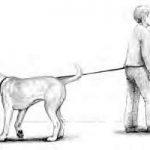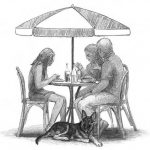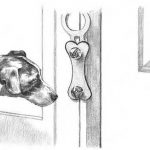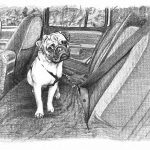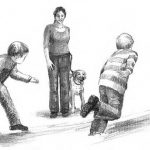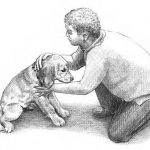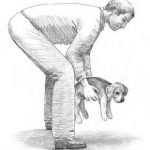Home Sweet Home
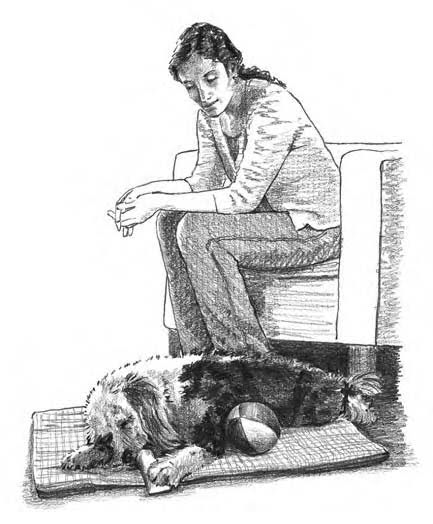
In This Chapter
- Shopping for supplies you’ll need immediately
- Checking out training collars and leashes to be used later on
- Readying your house and your family
- Making introductions
- Getting through the first week
Mom’s right again: First impressions really do count. To make your puppy’s transition into your home as smooth as possible, you have some choices to make — from where to put the crate to what to buy at the pet store. In this chapter, I lead you through the days building up to the main event and show you how to get everyone on board and how to outfit your home in preparation.
Shopping for Initial Supplies
Remember
Shopping for your puppy can be a mind-boggling experience. In order to avoid blowing your budget (and your mind), remember that less is more, at least initially. Though you may have the temptation to buy everything you can for your pup — from the latest toy to a designer raincoat — I suggest you bring a list and stick to it.
Bowls
Crate
Remember
Still not sold on crate training? Think about it this way: Having her own special place to play and rest is synonymous to giving a child his own bed and tucking him into it when it’s time to rest. You wouldn’t let a child sleep in the middle of a large, unprotected room, would you?
– Plastic crates are standard for travel and can also be used as an everyday crate in a well-ventilated environment. If you plan to travel, buy this type — it will give your pup more security when you’re away from home. It also will give your puppy more security when she’s away from the home.
– Wire crates allow for better air flow and viewing and can be covered with a blanket at night to create a more denlike experience. Dividers are also available to size the crate according to your puppy.
– A wicker crate is less of an eyesore. However, you have to pray that after paying top dollar, the puppy won’t decide to chew her way out!
Warning!
Crates can be an invaluable training tool, but they can also be emotionally destructive to your puppy if overused. Crates are ideal in the following situations:
– If you’re leaving your puppy alone for a duration of time not to exceed six hours.
– During sleeping hours for young, unhousebroken, or mischievous puppies.
– As a feeding station if your puppy is easily distracted.
– As a timeout for overly excitable pups. In this case, don’t use the crate as a form of punishment; simply lead your puppy there with a toy and place her in calmly. Sometimes, you both need a timeout from each other!
– It doesn’t communicate leadership.
– It separates you from your puppy when you’re at home.
– It can’t communicate how to behave in the house.
Tip
If the idea of a crate turns your stomach, or if you’re home all day and you can get through the early stages without one, use a playpen or small, gated room. If your puppy is older, you can lead or station her to keep her close as described later in the chapter.
Gate
– Close off a playroom when you’re around to supervise your puppy or play with her
– Block stairways
– Control your puppy’s access to a dangerous or off-limits room
Warning!
Some people feel less guilty when leaving their puppies in large gated areas, rather than in small rooms or crates. Big mistake. Big rooms make a puppy feel displaced and lonely — she may potty or chew out of sheer anxiety. Dogsare den animals who feel safest in small, manageable spaces. If your goal is peaceful separations, enclose your puppy in a crate or small enclosure when you leave for more than a few minutes. If you’re leaving for more than six hours, consider the playpen as a happy medium, and locate a dog walker to break up her day. See the next section for more info on playpens.
Playpen
Tip
A playpen, which is a fully functional enclosure, is quite the multifunctional little purchase. It can be used for the following purposes:
– Acclimating her to other pets
– Containing your puppy when you’re out of sight
– Keeping her out of wide thoroughfares
– Paper training her
– Temporarily containing her outside
Toys, bones, and treats
Remember
Your puppy’s first days will be spent nosing about — interactive play can take 2 to 4 weeks to emerge. Even older puppies have to get their bearings straight before they feel comfortable enough to play. Meanwhile, test your puppy’s likes and dislikes by giving her one toy or bone at a time. When you discover one that strikes her fancy, you can then buy multiples.
Toys
Bones
Tip
Personally, I’ve had the most luck with pressed rawhide, animal-part sticks, and vegetable-matter pulp bones. Test it out yourself — find a bone that satisfies your puppy’s craving, make sure it passes the “systems” test (her digestive system, that is), and buy it in bulk!
Treats
Warning!
Avoid grocery store treats. Most are junky and fill your puppy up with additives that can cause stomach upset, gas, and behavioral frustrations.
Bedding
Warning!
If the puppy has a strong chewing tendency, skip the bedding. Ingested blankets and towels can cause serious intestinal problems in puppies.
Tip
Take your pup’s mat with you wherever you go. It will help your puppy feel safe and at home whether you’re going to the vet, for a stay at the kennel, or on a family trip. It’s like having a security blanket!
Two leashes
A drag lead
A long line
Tip
Microchips: Built-in lifesaversYour veterinarian and breeder are likely to suggest that you microchip your puppy. I strongly recommend this too! Your veterinarian will inject into your puppy’s neck or shoulder (no more painful than a typical shot) a preregistered, computer-recognizable identification chip. If your puppy gets lost or ends up at a shelter, a simple wave of the wand allows your puppy to be returned to you immediately. Many breeders have a microchip inserted in each puppy’s shoulder before sending them home. If your pup hasn’t had a microchip inserted, make an appointment immediately. |
ID tag
Remember
I suggest that you not add your puppy’s name to her tag because it could endear her to wrongdoers. Also, you can add the word “Reward” if you’re prepared to offer one.
A few other odds and ends
– Treat cups: To create a treat cup for your puppy, purchase an inexpensive plastic container (or use an emptied deli container), cut a small round hole in the lid, and fill it half full with dried kibbles or broken-up dog treats. By connecting the sound of the cup shaking with a food reward, you can use the treat cup to cheerfully condition your puppy’s cooperation from game playing to name association to fetching.
More on its uses in Chapters Kids and Puppies and Using Cool Tools and Groovy Gadgets.
– Snack packs: Purchase or find a fanny pack. Stow snacks and poop bags in it and take it with you when you go outside with your pup. You’ll have the snacks handy for rewarding your puppy for returning to you and for outdoor pottying. Check out Chapter Using Cool Tools and Groovy Gadgets for more uses of snack packs.
– Clicker: A clicker is a small handheld toy that, when depressed, lets out a clear noise that is unmistakable. When this sound is paired with a treat, your puppy will go to great lengths to initiate the noise. You may use the clicker to teach basic skills or shape household manners like housebreaking and greeting rituals. Flip to Chapter Using Cool Tools and Groovy Gadgets to find out more.
As Puppy Grows Up: Training Leashes and Collars
Remember
Training collars and leashes may make you and your puppy’s lifestyle feel restricted, even overly structured. When used properly, however, they aid in helping your puppy to earn household freedom — besides, using them is a temporary thing!
Training leashes
Retractable leashes
Remember
You do need to take a few precautions, however. Don’t use a retractable leash near roads or heavily populated areas. Its high-tech design takes getting used to, and even a seasoned pro can lose hold of the slack. If you’re out with other people, watch their legs. Most puppies get a little nutty when you give them some freedom to run. If a person gets sandwiched between you and your prancing puppy, he’s in for a wicked rope burn. It’s best to keep playtimes private.
Teaching Lead or equivalent
Tip
To keep it simple and structured, you can use a technique called the Teaching Lead Method, which I explain in more detail in Chapter Teaching Everyday Etiquette. The three aspects of this method — leading, anchoring, and stationing — are invaluable to condition your puppy to household freedom and civilized walking manners. Use this chapter to find out how the Teaching Lead Method can
– Take the place of the crate when you’re home.
– Encourage good manners inside and out.
– Teach everyday commands, such as “Stay,” “Heel,” and “Come.”
– Resolve housebreaking, jumping, nipping, and other annoying habits.
Seat Belt Safety Lead (SBSL)
Tip
You can reference my Web site (www.dogperfect.com) for photos specifying leash use and collar options.
Short lead
– Encouraging good manners. A lot of clients complain that their puppies behave like a saint on leash, but when they take the leash off, the old derelict emerges. A short leash can serve as a nice transition from using a regular leash to full-fledged freedom. Wearing a short lead reminds the puppy that you’re still watching her; it also gives you something to grasp for correction purposes if you need to.
– Off-lead training. When you progress into off-leash work (see Chapter Graduating to Off-Lead Control), the short lead again serves as a reminder of your presence and authority. In addition, it gives you something to grab graciously if your puppy slips up.
Training collars
Remember
You can’t simply ask for a training collar. You need to be more specific. Many different types of collars are available, and finding the one for your situation is a must. An ineffective training collar can hurt your puppy, as well as hinder the training process.
Warning!
Although head collars and no-pull harnesses (discussed later in this section) are safe options and will condition cooperative walking skills from the start, avoid using all other training collars on a puppy younger than 16 weeks. Remove the collar when you leave your pup unattended because it can be deadly if snagged. Put your puppy’s tags on a buckle collar.
Head collar
Remember
You may think this collar looks like a muzzle when you first see it. Trust me, though; it’s not a muzzle. Puppies can eat, chew, and play happily while sporting their head collar. In fact, using this collar is probably the most humane way to walk a dog. It eliminates internal or external pressure around the neck. Using it is similar to handling a horse on a halter.
– Wearing time. How often you should leave the head collar on is a question best answered by your puppy. If yours is relatively well behaved, you can use it exclusively during walks and lessons. If she’s the mouthing, jumping, or barking type, leave the collar on whenever you’re around. Remove it at night or when you’re out.
– Sizing your head collar. Head collars have a sizing scale. The head collar must fit properly around your puppy’s neck. If it’s too loose, your puppy can pull it off and perhaps chew it. You want the neck strap to fit watch-band tight around your puppy’s neck about her ears, with enough room to fit two fingers under her neck. You may need to tie a knot with the remaining slack after you adjust it to prevent it from loosening.
– Observe how your puppy reacts. Initially, puppies don’t love the idea of a head collar. Their reaction reminds me of the first day my mother dressed me in lace — I hated it. But after an hour or so, I hardly noticed it at all. I learned to tolerate it. So will your puppy. When you see her flopping about like a flounder, take a breath. After she realizes she can’t get the collar off, she’ll forget about it. Some puppies take an hour to adjust to the feel of the collar; some take a day or two. If you give this collar a try, you may have to tolerate some resistance. Be patient.
Tip
If a head collar irritates your puppy’s nose, buy Dr. Scholl’s moleskin at the drugstore and wrap it around the nose piece. It’s softer and will feel more comfortable. If that treatment is ineffective, remove the head collar and contact your veterinarian for ointment.
Harnesses and other gadgets
The original correction collar
Warning!
If put on backwards, this collar will catch in a vise hold around your puppy’s neck and do what the collar is not supposed to do — choke.
1. Decide which side you want your puppy to walk on.
You must be consistent; puppies are easily confused. Because left is traditional, I use left as my reference.
2. Take one loop of the collar and slide the chain slack through it.
3. Create the letter P with the chain.
4. Holding the chain out, stand in front of your puppy. Show her the chain.
5. Give your puppy a treat as you praise her and slide the loop of the P over her head.
Remember
In order to effectively train your puppy with this collar, you must master the “zipper tug.” Your puppy should learn by the sound of the collar, not the restraint. When used properly, a quick tug, which sounds like a zipper, corrects your puppy’s impulse to disobey or lead. Practice the zipper tug without your puppy:
1. Stand up straight and relax your shoulders, letting your arms hang loosely at your sides.
2. Place your hand just behind your thigh and snap your triceps so that your elbow swings back freely.
If it helps, pretend that someone else’s hand is there and you’re trying to hit it.
Tip
How many ways do you think you can hold the leash? Just one way when you’re training your puppy. If you hold the lead improperly, pulling up instead of back, you’ll pull your puppy off the ground, which chokes her. To hold the leash correctly, wrap your thumb around the bottom of the lead and your fingers over the top. Keep your arm straight as you walk your puppy and quickly tug straight back when necessary.
Nylon training collar
Self-correcting collar
Warning!
If you decide to try this collar, let me warn you: Occasionally, these collars pop off. To prevent a possible emergency, purchase an oversized training collar and attach your leash to both when walking in an unconfined area. Use this collar only when you’re working with your puppy on a leash.
Prepping Your House for Your Puppy’s Arrival
Puppy’s room
Remember
Your puppy needs her own space to get away from the hubbub. Because a tired puppy can become ornery (just like you), designate a quiet area that can be darkened like a child’s nursery. Whether you choose a crate or a gated room, make it cozy by laying down a flat mat and a couple of toys to occupy her when she’s restless (think pacifier). Avoid fluffy beds or cushions because both can encourage chewing or accidents. A radio can be placed nearby to play calming music while you’re out of the room.
Tip
An especially helpful product for puppies is called a SnugglePuppy, which mimics the warmth and comfort of a pup’s mom. The substitute companion has a pocket for heating packs and has a motorized beating heart. These features make the SnugglePuppy ideal for easing your puppy’s transition from her first family to her final one.
Free play zones
Tip
If your free play zone will correspond with another pet’s domain, reorganize their area well in advance of the puppy’s arrival. For example, if your cat’s bowls and litter box are within the puppy’s area, relocate them ahead of time so that your cat won’t feel displaced by the new arrival. For more tips on introducing your pup to the resident pets, flip to the section “Introducing other pets,” later in this chapter.
Play stations
Feeding areas
Remember
Feed your puppy by her play station in her free play zone or, if she’s distractible, in her crate. Place one dish for water and one for food. Take up the bowls at appropriate times and wash the dishes after every feeding.
The route
Tip
Place papers in the decided area or select a door and potty area no more than 10 to 20 feet from your home’s entrance.
The Ride Home
Tip
Make every effort to plan as stress-free a trip home as possible. If you can, arrange the trip during her nap time. Also think through both the best- and worst-case scenarios, so that you’ll be prepared for anything that may happen. For example, think of the following scenarios:
– Best-case scenario: Your puppy will sleep the entire way home. Keep your energy subdued and speak softly to your puppy if she wakes up. Calming music may also be effective.
– Worst-case scenario: Your puppy will throw up, howl, or have an extreme case of diarrhea. The worst-case scenario is a drag, I know, but it happened to me once and it may happen to you. Pack three rolls of paper towel, plastic bags, your favorite carpet or upholstery cleaner, and towels. No matter how disappointed, disgusted, or frustrated you become, don’t stress or correct your puppy.
Remember
Here’s your checklist for the trip:
– Paper towels
– A towel to spread under the crate to prevent slipping or to clean up accidents
– Light collar with an identifying phone number in case of emergency or accident
– A few chewies or a soft toy
– A SnugglePuppy, if you’ve purchased one — batteries and heat packs included
Tip
If you’re traveling in a car or by plane, crate your puppy in an appropriately sized plastic kennel. Plastic kennels can be purchased at a local pet store in advance. Ask the breeder or caretaker what size is most appropriate for your pup. In the car, secure the kennel by bracing it with pillows or literally tie it down on a leveled surface and play calming music as you navigate home. If you’ve purchased a SnugglePuppy, use it now and for the next few days to help ease your puppy’s sense of isolation. If others are riding with you, ask that they sit near the opening of the kennel and speak softly to the puppy when she wakes up.
Warning!
Don’t sit the puppy in your lap while driving. Driving is enough of a chore, and to make matters worse, a slight fender bender may release the air bag. Like infants, your puppy won’t survive the blow.
Making the First Introductions
Tip
If you’re welcoming home a young puppy, between 8 to 12 weeks, introduce her to one main room, such as the kitchen, for the first week. An older puppy can be gradually exposed to new areas of the house, but make sure you use a leash because unleashed she’s likely to explore or chew or soil areas you rather she not. You’ll be forced to interfere, which can cycle into a pattern of behavior because your attention is the strongest reinforcement. On leash a gentle tug can guide her to areas or toys and help her to format acceptable behaviors from the start. If you’re planning to let your new pup sleep near you at night, use a large, open box or crate as a bed and carry her there after her last potty run.
Rolling out your welcome mat
Tip
Explain the situation ahead of time and ask your children to help you make the puppy feel comfortable. The rule is that they can follow quietly and speak gently, but roughhousing, shouting, and fighting is forbidden. This may be your last peaceful moment for a while, so enjoy it!
Forming a welcome circle
Calming the kids
Remember
If you have more than one child, chances are likely that they’ll compete with each other for the puppy’s attention. Here are a few tricks I’ve found useful in dispelling early tension, frustrations, and physical fights:
– Model, model, model: The saying “Monkey see, monkey do” applies to children, too! Because your children pick up on habits by watching you, show them how to act with actions instead of words. I can assure you that something is bound to not go as planned (your child will have a tantrum, your partner will not be as excited or interested as you), but if you stay calm and ignore the impulse to badger or boss, you’ll have a calmer home on your hands. Kids, and even some spouses, react poorly to negative reprimands. Stay cheerful and model the right behavior as your children are watching. Like monkeys, they see — and then they do.
– Assign tasks: Assign everyone a task ahead of time by using the chart in Chapter Kids and Puppies. Make raising the puppy a fun family affair where everyone plays the role of the parent.
– Advanced discussions: Talk to your children ahead of time. Get them involved in your plans and warn them of all the possible situations that may arise. Tell them that the puppy may be sad and withdrawn and may not want to interact with anyone. Though this may be a letdown, you must respect the puppy. The transition is rough, but she’ll snap out of it in a few days and will be delighted to have such a respectful, loving group to bond to. On the other hand, the puppy may be nippy and rough. So that the children don’t go running from the room, make sure they’re aware and help them interact with the puppy when she’s calm.
– Watch, listen, and share: Have a talking toy to pass around the table at mealtimes. Whoever has the toy gets to share a story or a thought about the puppy. We have a sharing shell at our house and whoever has the shell gets to talk (uninterrupted) for as long as they want.
– Take the puppy away: Your puppy will get easily riled by your children and may express herself through nipping, jumping, and tugging. To prevent this behavior, tell your children in advance that if they get too riled up, you’ll take the puppy aside. The key to this technique is to follow through.
Tip
Talk to your kids about the different phases of puppyhood — comparing it to different-age children they know. Using the section “The Five Stages of Puppy Development” in Chapter Socialization and Civility, help your kids understand exactly what’s going on with your puppy at each age.
Introducing other pets
Tip
Here are some tips to help ease the tension:
– Keep your new puppy in a confined area. If you choose an area (the kitchen, for example) that has been the feeding area for your other pet, think ahead. A week before your puppy comes home, change the feeding area to a quieter environment. Do this for litter boxes and caged pets, as well. Move them well ahead of time to ensure a positive association.
– After your puppy is in the home, introduce the smell of the resident pet to your puppy first. Then take a blanket from the pup and place it near your resident pet.
– If the resident pet is caged, bring your puppy into its room after a meal and playtime. This restful state calms the scenario. Bring in your puppy’s favorite mat and chew toy and sit near the cage, petting your puppy calmly. Repeat this exercise often.
Royalties to the resident pets
– Feed them first (dividing their meals into three parts if necessary).
– Treat, greet, and play with them first and foremost.
– If the resident is a dog, let her pass first (on stairs or through doorways).
– If your resident pet approaches you while you or anyone is interacting with the puppy, turn away from the puppy and address her immediately.
Remember
If you follow these tips, I assure you that your puppy’s feelings will not be hurt. She’ll grow respectful of your other pet and act accordingly. Aside from conditioning your resident to the idea that the new addition guarantees more food and attention for her, you’re reinforcing respect for those pets who came first.
Other dogs
– Organize the introduction, preferably at a time your resident pet is most calm.
– If you’re introducing a young puppy, have a friend hold her (if she’s not inoculated, don’t let her frolic in an open environment) as you approach with your dog on a loose leash.
– Feed your dog treats as you focus your attention on him.
– Once he’s accepting, invite your friend to carry the puppy into your home.
– If you’re concerned about your dog’s reaction, buy a playpen or crate ahead of time and place the puppy in it as you continue to react with your dog as though the puppy were not there.
– Stay calm as they interact and keep your attention focused on your dog. If any altercations happen, side with your resident. It’s normal for him to “put the puppy in her place,” using seemingly dramatic postures. Stay calm and let them work it out.
– If you’re introducing an older puppy, bring the two to an enclosed space and let them greet each other on their own terms. If you’re nervous, you can muzzle both dogs, although I don’t recommend it. Let them figure each other out, and then let your resident lead the new puppy into the home.
Remember
Growling, teeth snarls, and pinning are actually very good signs of normal acceptance. The big dog is showing the little dog who is boss. Your puppy may actually shriek, roll over, and pee. Again, don’t interfere. If you comfort the new puppy, you may alienate your resident dog and make the relationship between them rocky. The puppy shrieks communicate volumes and let the big dog know just how submissive and defenseless the little dog is. It is all good. Let them work it out in their own way.
Tip
If you’re earnestly concerned that your resident dog might harm the puppy, muzzle him or leave a leash dragging to enable easy interference.
Cats
– If you’re introducing a cat, place the puppy in an enclosed room or crate (with a special chewy for diversion) and let your cat wander around the room at his own will. Don’t try to influence or interfere in your cat’s reaction. If your puppy starts acting wildly, however, step in to calm her.
– When your cat is accustomed to the puppy’s presence (it may take awhile, perhaps a week), place your puppy on a light drag lead and bring the two together in a small room. Hold your puppy’s lead if she acts up and divert her with a toy.
Don’t be too surprised if your cat growls or bats at the puppy. Corrections only make matters worse. Your cat is defining her space, which is a necessary boundary for coexistence.
Tip
If your cat can’t come to grips with the idea, keep the two separated until your puppy is acclimated to a leash and collar and can understand the concept of “No.”
Other animals
– If you have a free-roaming animal, introduce him as you would a cat.
– If this animal generally lives in a cage, bring the cage out when your puppy is calm and her needs (eat, bathroom, play) have been satisfied.
– If your puppy is impulsive, sniffing intently, place her on a head collar before you proceed.
– Use treat cups and/or a clicker to keep her focus on you while you simply hang out as if there were no cage in the room. If she looks at the animal calmly, fine; if she gets overstimulated, tug her leash and say “No.” Redirect with a familiar cue. Work at short 10- to 20-minute intervals until your puppy is calm around your other pet.
Warning!
When I was a kid, I got a French lop-eared bunny. Shadow, the bunny, grew to be a whopping 24 pounds. Unfortunately, another favorite pet of mine, Shawbee, my Siberian Husky-Shepherd mix, decided that 24 pounds was big enough. The inevitable happened: Shawbee ate Shadow. It was a horrible sight to see. The moral of this story is that if your puppy won’t give up her snackhunting vigil, you may have to reconsider keeping both under the same roof.
Saving your friends for another day
Warning!
Sometimes your friends can be the hardest to control. Many will have opinions and will, without provocation, share their views on everything from housetraining to how to discipline your puppy when she misbehaves. Promise me one thing: You won’t listen to them. Even though they may speak the gospel about what worked for their puppy, you’re not raising their puppy — you’re raising your own. Like children, what works for one pup may not work for another. If you follow everyone’s advice, you risk confusing your puppy. If you need more help than this book offers, skip your friends’ advice and sign up for a class or call a respected professional.
Tip
When the time has finally come for you to introduce your new pup to your friends, here are some tips for the formal introductions: Ask your guest to come in calmly and sit on the floor. If your puppy is jumpy and excited, show your guest how to “close shop” by folding his arms in front of his face. Brace your puppy by clipping your thumb over her collar and resting your other hand on her back (Chapter Life from His Paws: Understanding Your Puppy’s View of the World). If she’s still too excited or nervous, offer her a toy to dispel her anxiety. By ignoring her when she’s excited and petting her when she’s calm, you’re getting a head start on encouraging good manners.
What to Expect the First Week
Remember
Speak to her softly and don’t correct her or respond if she has an accident or chews on something she shouldn’t. Right now, she’s too disoriented to retain anything, so you’ll only succeed in frightening her. Relax. You’ll do fine. This is just the beginning.
Surviving the first 24 hours
Tip
Initially, enclose her in a room and just observe. If she seems interested in your presence, follow her about, preferably on all fours. If she sniffs, sniff back. If she’s interested in looking out the window, join her. Reflect her interests calmly. If your puppy wants to rest, be a quiet presence. When she wakes up, take her to her designated potty place and give her water. Try not to overwhelm her with your interests or affections. She needs time to adjust.
Days 2–7
Remember
Right now, the most important lessons are
– Helping your puppy learn her name as outlined in Chapter Teaching Everyday Etiquette.
– Teaching her where to potty as described in Chapter Housetraining for Success.
Bonding moments
Remember
The best approach is to follow your puppy’s rhythm for the first week as she is getting acclimated to her new home and all the others in it. If your puppy wants to sleep, let her — put her in her crate or on her play mat. At feeding time, put her food on or near her mat and leave her alone for 15 minutes. Don’t worry if she doesn’t eat. She’s probably just nervous. Give her some water and take her to her potty spot often.











